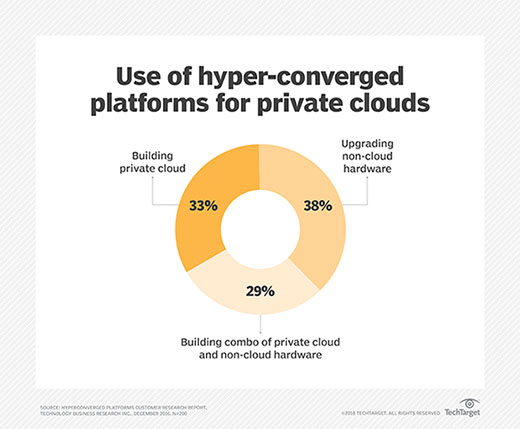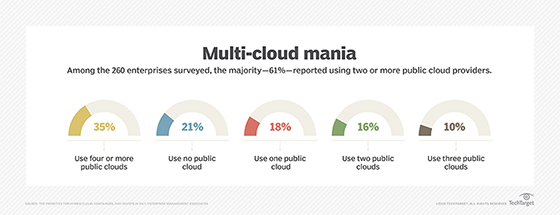
carloscastilla - Fotolia
Essential hyper-converged cloud questions answered
Hyper-convergence can help make taking a cloud or multi-cloud approach to your architecture easier to implement, manage and scale. Read on to find out how and why.
The cloud and hyper-converged infrastructure virtualize resources in similar ways. It is, in large part, this shared trait that has enabled these two seemingly disparate IT infrastructure types to become cohorts in an up-and-coming IT architecture called the hyper-converged cloud.
Hyper-converged clouds can take a number of different forms. The HCI cloud can refer to an on-premises hybrid or private cloud built on an HCI platform, a cloud service provider (CSP) using HCI as part of its data center architecture or when a local HCI system in an enterprise connects to virtualized servers in the public cloud.
Clearly, hyper-convergence can serve as a steppingstone to the cloud and vice versa. There are a number of things you should know and questions that need answering before you make the leap to the hyper-converged cloud, however. We cover a few of the more important ones below.
What are the basics of the hyper-converged cloud?
At the core of the cloud and HCI is the virtualization of resources into virtual machines as virtual servers, file servers and production machines. For private clouds, hyper-convergence can ease and simplify implementation and management, while cutting costs and saving resources.
With a hybrid cloud, hyper-convergence can make it easier to integrate a private, HCI-based cloud or a standard enterprise IT infrastructure with a public cloud. And one way an HCI cloud can benefit a CSP is by reducing or eliminating the noisy neighbor problem, whereby one tenant uses too many resources at the expense of another. Read here to learn more about the benefits of hyper-convergence and the cloud in all its forms.
How can hyper-convergence increase private cloud success?
The cloud promises rapid scalability to respond quickly to business needs, fast time to value and speedy self-service provisioning of IT resources. These advantages are difficult to achieve with a private cloud using traditional data center architecture. Hyper-convergence can help by making your private cloud more cloudlike to enable the incremental expansion of resources -- compute, storage, network, etc.
With HCI, compared to typical data center architectures, it may take hours rather weeks to build the full virtualization infrastructure necessary to support a private cloud. This enables organizations to swiftly deploy a private cloud and to start small and then easily build out as needed. Learn more about why HCI and the private cloud make a good match.

Why would a CSP build its cloud on a hyper-converged platform?
Enterprises aren't the only ones that can reap the benefits of a hyper-converged cloud. CSPs take advantage of HCI platforms as well to extend the shelf life and profitability of their cloud platforms.
Hyper-convergence can, for example, help CSPs with platform sizing, which is often difficult to determine because of typically fixed-size server clusters -- too large and profitability is difficult to achieve; too small and overloading is a real possibility. Since HCI clusters scale by nodes, determining platform size is less of a risk. It's easy to expand a small-cluster HCI cloud as the demands of current or future workload requirements increase. See what other advantages CSPs can gain from the hyper-converged cloud.
Does HCI software and hardware matter to your cloud-based application workloads?
All hyper-converged hardware and software aren't the same, nor will the applications that run in an HCI environment thrive on the same HCI hardware and software. You must choose the right hardware/software mix for your workloads when deploying an HCI platform to run your private cloud.
Consider elements such as virtualization, the role of the hypervisor, the automation and orchestration engine, user self-service capabilities and integration opportunities when weighing what HCI hardware and software to buy and implement. Read on to learn more about selecting the right HCI hardware and software for your hyper-converged cloud and applications.
What are HCI vendors doing to better support multi-cloud environments?
Hyper-converged vendors differentiate their products in several different ways. For instance, they often do this with features such as cluster size, node size and configuration, storage type, hypervisor support, container deployment, customer support and, increasingly, multi-cloud.
The last is important because multi-cloud -- using two or more cloud computing services -- has become part of the cloud norm for enterprises over the last couple of years.

This has, in turn, led HCI vendors to follow suit with more support for multi-cloud environments in their products. See how Dell EMC, Nutanix, Cisco, NetApp, Scale Computing and Pivot3 have brought multi-cloud support to their HCI products.







